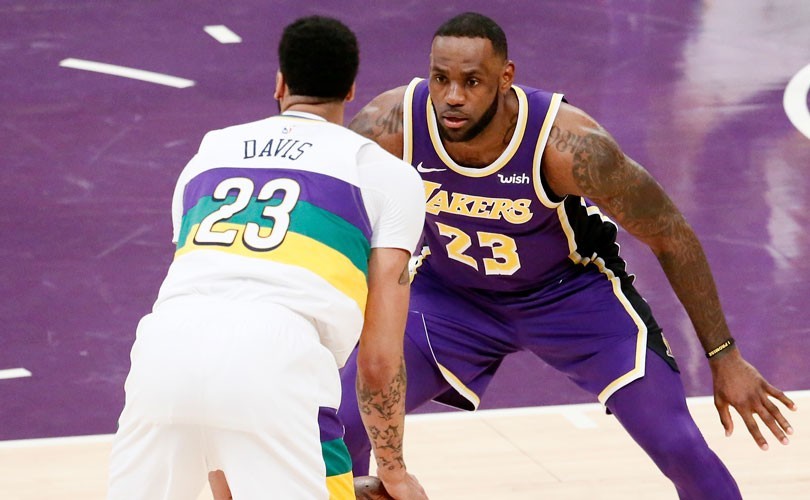The Latest Trend in the NBA: Recruit Your Own Teammates (and What It Means for the Rest of Us)
ESPN.com called it “the wildest NBA week ever,” the first few days of the free-agent signing period earlier this month. Superstars were in constant motion, and a fascinating trend emerged that has implications for recruiters and businesses everywhere: The league’s best players are now recruiting their own teammates.
To some extent, this is what happened when the Warriors signed Kevin Durant three years ago. Golden State brought its top four players, including two-time MVP Stephen Curry, to the Hamptons to woo the sharpshooting big man. But that was different — that courtship was orchestrated by the team, not the players.
This time around, the players took charge. LeBron James recruited forward-center Anthony Davis to come from New Orleans and play with him on the Los Angeles Lakers. In an even more stunning turn of events, Kawhi Leonard signed with the Los Angeles Clippers — after recruiting six-time All-Star Paul George to join him there. Fresh off leading the Toronto Raptors to their first title, Kawhi, who many consider the NBA’s quietest superstar, nonetheless found the persuasive skills to get PG-13 to demand a trade. Now the Clippers are the early favorites for next year’s title.
Perhaps no industry experiences a skills gap to match the one faced by the NBA. After all, how many people anywhere in the world are insanely tall and can run like the wind, jump like an impala, and constantly hit a 23-foot jump shot with a hand (usually a very large hand) in their face?
In a tight labor market, companies should leverage their employees to help attract talent. Recruiters need to start looking not just for superstar employees, but for superstar employees who are also talent magnets.
Recruiting, like leadership and communication, shouldn’t be cordoned off into just one department. Here are five tactics for getting your workforce to help you close the skills gap:
1. Create a companywide recruiting culture in which everyone has an eye out for talent
At LinkedIn, talent is our No. 1 operating priority. Apparently, that’s also true at GoDaddy, which sent every employee a hand-held mirror with a note that said, “This is what a GoDaddy recruiter looks like.”
Netflix is another company that has built a formidable recruiting culture, which allows it to fulfill its promise to candidates that, should they be hired, they will have a chance to work alongside “stunning colleagues.”
Nellie Peshkov, the streaming giant’s vice president of talent acquisition, says that managers at her company take recruiting “so seriously” that hiring managers and recruiters call each other “partner.” Nellie suggests that to start building this kind of culture TA teams should sit down and source together with hiring managers; become subject matter experts in the areas for which they’re sourcing talent; speak up confidently about candidate assessments; and share their views about macrotrends at the company or in the industry that affect hiring.
One of the trends they might point to is that superstar performers have started recruiting other superstar performers.
2. Have an employee referral program that is easy to take part in, highly responsive, and heavily promoted
Hires made on the basis of employee referrals are quicker and less expensive and generally perform better and stay around longer than employees sourced by any other method (and, as a bonus, referring employees also tend to have a longer tenure).
So, a good referral program is a critical part of a winning talent acquisition strategy. And the single most important aspect of an effective referral program is how easy it is to take part in. The less work an employees has to do to refer a candidate, the more successful the program will be, says Kara Yarnot, VP of strategic consulting services for HireClix.
Some companies simply ask employees to forward resumes and contact information to their recruiting teams. Kara once worked for a large construction company where she built a referral program to support the sales team. Employees who met a great salesperson — selling them a house, a car, a pair of jeans — had only to get that person’s business card and pass it along to the TA team.
––––––––––––––––––––––––––––––––––––––––––––––––––––––––––––––––
Related: How the NBA’s Top Teams Recruit Top Coaches — and What You Can Learn from Them
––––––––––––––––––––––––––––––––––––––––––––––––––––––––––––––––
In a thriving referral program, employees feel like their recommendations are taken seriously, and this only happens when they hear back from the talent acquisition team in a timely and consistent manner. Referrers need to know that they’ll hear back from someone in TA within 48 hours or five days or whatever standard you put in place (but the faster the better).
For a program to take flight and really elevate your talent efforts, it needs to be promoted, loudly and consistently. At LinkedIn, CEO Jeff Weiner and the rest of the leadership team have touted the importance of referrals. Enterprise Rent-A-Car turned referrals into a competition.
3. Celebrate the employees who help find new talent
The standard way to acknowledge employees who refer a candidate who later gets hired is with a cash bonus. Some companies take it a step further and offer larger payouts for new hires who add diversity to the workforce or occupy hard-to-fill roles. Still other companies, such as InMobi and Google, increased their referrals by offering prizes instead of money.
No budget? No problem. There are other ways to lavish kudos on your best referrers. Bonus or not, every employee should be thanked with a note from the talent team for a referral that leads to a hire. A shout-out at an all-hands meeting or a companywide congratulatory email is also a good way to acknowledge an employee’s contribution — and get their colleagues thinking about referring too. And at LinkedIn, employees who have two or more referrals hired during a single quarter are up for a Talent Magnet Award.
4. Focus your attention on new employees, who are more likely to refer people they know
A few years back, LinkedIn discovered that people are most likely to refer in their first six months on the job. So, we make sure to emphasize the importance of referrals in a new employee’s first few months with us.
PURE Insurance understands the opportunity that new employees present. PURE sources 40% to 60% of its hires from referrals, and they do this in part by having recruiters ask new employees in their first 30 days if they know anyone who would be a good fit at the company.
Booking.com doesn’t even wait until someone’s first 30 days. When a candidate is crushing their interview, a recruiter will ask if they know someone else who would be good at Booking.com, someone who the candidate would like to work with. If the referral is hired, the referrer gets a bonus — after they’ve started working for the company.
5. Make sure your list of go-to interview questions include at least one about recruiting
I scoured a half-dozen lists of “best” interview questions and not a single one suggested asking about how well a candidate is connected to other people in their industry or discipline. Clearly, it’s more important to know what kind of spirit animal your candidate is (or how many tennis balls can fit in a limo) than what kind of talent they’ve helped bring in at their previous jobs.
With talent at a historic premium, companies may need to find a place to ask candidates about their virtual Rolodex. How many connections do you have on LinkedIn? How many of those connections are in your field, and how many do you know well enough to possibly bring them to a new company? Who, if anyone, did you bring into your last company?
Final thoughts: A talent magnet can be a game-changer
We shouldn’t lose sight of why we’re hiring people.
So, it goes without saying that the Clippers signed Kawhi to a $100 million+ contract not because he can recruit but because he is the league’s best defender, scores nearly 27 points a game, and snares seven rebounds a game with mitts so massive his nickname is The Claw.
In the same way, you want to hire a five-star software engineer because they are going to create best-in-class code for you, not simply because they know a lot of talented people. (You know a lot of talented people too.)
But whether you’re looking for talent in sales, finance, HR, or basketball, a world-class performer who can help you attract other world-class performers may be the very thing that elevates your company to the top of its game.
To receive blog posts like this one straight in your inbox, subscribe to the blog newsletter.
* Image from Getty
Related articles




